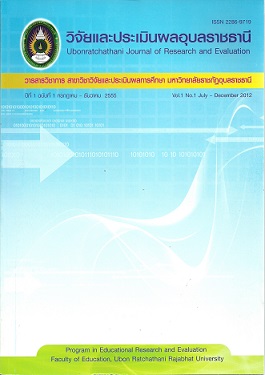การปฏิบัติการพัฒนาความคิดสร้างสรรค์ทางภาษา โดยใช้วิธีการสอนเพื่อการสื่อสารวิชาภาษาอังกฤษ นักเรียนชั้นประถมศึกษาปีที่ 6 โรงเรียนบ้านจันลา สังกัดสำนักงานเขตพื้นที่การศึกษาประถมศึกษา อุบลราชธานี เขต 5 45-56
คำสำคัญ:
การพัฒนาความคิดสร้างสรรค์ทางภาษา โดยใช้วิธีการสอนเพื่อการสื่อสาร, การวิจัยปฏิบัติการ, ความคิดสร้างสรรค์ทางภาษาบทคัดย่อ
การวิจัยครั้งนี้มีจุดประสงค์เพื่อศึกษาการปฏิบัติการพัฒนาความคิดสร้างสรรค์ทางภาษา โดยใช้วิธีการสอนเพื่อการสื่อสาร วิชาภาษาอังกฤษ ของนักเรียนชั้นประถมศึกษาปีที่ 6 และเพื่อเปรียบเทียบผลการปฏิบัติการพัฒนาความคิดสร้างสรรค์ทางภาษาก่อนและหลังการปฏิบัติการโดยใช้วิธีการสอนเพื่อการสื่อสาร วิชาภาษาอังกฤษ ของนักเรียนชั้นประถมศึกษาปีที่ 6 โรงเรียนบ้านจันลา สำนักงานเขตพื้นที่การศึกษาประถมศึกษาอุบลราชธานี เขต 5 กลุ่มเป้าหมายที่ใช้ในการวิจัยได้แก่ นักเรียนชั้นประถมศึกษาปีที่ 6 โรงเรียนบ้านจันลา สังกัดสำนักงานเขตพื้นที่การศึกษาประถมศึกษาอุบลราชธานี เขต5 ภาคเรียนที่ 2 ปีการศึกษา 2554 จำนวน 25 คน ได้มาโดยการเลือกแบบเจาะจง เครื่องมือที่ใช้ในการวิจัย แบ่งเป็น 2 ประเภทคือ 1) เครื่องมือที่ใช้ในการทดลอง คือ แผนการจัดการเรียนรู้โดยใช้วิธีการสอนเพื่อการสื่อสาร เพื่อพัฒนาความคิดสร้างสรรค์ทางภาษา จำนวน 12 แผน มีค่าเฉลี่ย 4.62 อยู่ในระดับดีมาก 2) เครื่องมือที่ใช้ในการเก็บรวบรวมข้อมูล ได้แก่ (1) แบบทดสอบวัดความคิดสร้างสรรค์ทางภาษา มีค่าอำนาจจำแนก 0.30-0.32 และค่าความเชื่อถือได้ทั้งฉบับ 0.971 (2) แบบทดสอบท้ายวงจร วงจรที่ 1 มีค่าอำนาจจำแนก 0.29- 0.32 ค่าความเชื่อถือได้ 0.977 วงจรที่ 2 มีค่าอำนาจจำแนก 0.31-0.33 ค่าความเชื่อถือ 0.976 และวงจรที่ 3 มีค่าอำนาจจำแนก0.29-0.32 ค่าความเชื่อถือ 0.977 (3) แบบบันทึกการสังเกตพฤติกรรมการสอนของครู (4) แบบบันทึกการสังเกตพฤติกรรมการเรียนรู้ของนักเรียน (5) แบบสัมภาษณ์นักเรียน (6) แบบบันทึกผลหลังการจัดการเรียนรู้ สถิติที่ใช้
ในการวิจัยคือ ร้อยละ ค่าเฉลี่ยของประชากรและส่วนเบี่ยงเบนมาตรฐาน
ผลการวิจัยพบว่า
- การปฏิบัติการพัฒนาความคิดสร้างสรรค์ทางภาษา โดยใช้วิธีการสอนเพื่อการสื่อสาร วิชาภาษาอังกฤษ ของนักเรียนชั้นประถมศึกษาปีที่ 6 โดยกระบวนการวิจัยปฏิบัติการ หน่วยการเรียนเรื่อง Life style ได้ผลการปฏิบัติการ
มีลักษณะเป็นบันไดเวียน 3 วงจร ประกอบด้วย วงจรที่ 1 เรื่อง Occupation วงจรที่ 2 เรื่อง Food and Drink วงจรที่ 3 เรื่อง My Free Time ผลการปฏิบัติการในวงจรปฏิบัติการที่ 1 พบว่าขั้นวางแผน วางแผนการสอนโดยใช้วิธีการสอนภาษาเพื่อการสื่อสาร ตามรูปแบบการสอนของ Littlewood ซึ่งมีขั้นตอนในการสอนภาษาเพื่อการสื่อสาร ขั้นปฏิบัติการ การจัดกิจกรรมการเรียนการสอนไม่ทันตามแผนที่กำหนดไว้ ยังไม่เป็นระบบ ขั้นสังเกตการณ์บันทึกผลการจัดการเรียนรู้และสัมภาษณ์นักเรียนนักเรียนให้ความร่วมมือในการดำเนินกิจกรรม นักเรียนไม่เข้าใจในขั้นตอนการเขียน ต้องการทำกิจกรรมกลุ่มและเกณฑ์การประเมินยากมากเกินไป ขั้นสะท้อนผลการปฏิบัติ หลังจากสิ้นสุดการปฏิบัติการในวงจรที่ 1 พบว่านักเรียน จำนวน 10 คน ไม่ผ่านเกณฑ์ร้อยละ 60 ของคะแนนเต็ม ครูจึงสอนซ่อมเสริมให้กับนักเรียนดังกล่าวโดยใช้เวลาในชั่วโมงซ่อมเสริม ผู้วิจัยได้ใช้แผนการจัดการเรียนรู้เดิม โดยปรับเวลาในกิจกรรมขั้นนำไปใช้ เพื่อพัฒนาความคิดสร้างสรรค์ทางภาษาให้นักเรียนได้ฝึกมากขึ้น ให้นักเรียนทุกคนได้ฝึกและมีส่วนร่วมในกิจกรรม พร้อมทั้งอธิบายและยกตัวอย่างให้ชัดเจนและบอกเกณฑ์การให้คะแนน ให้กับนักเรียนอย่างละเอียด หลังการสอนซ่อมเสริมนักเรียนทุกคนผ่านเกณฑ์ร้อยละ 60 ของคะแนนเต็ม ผลการปฏิบัติการในวงจรปฏิบัติที่ 2 พบว่า ขั้นวางแผน นำข้อดี ข้อบกพร่อง ในวงจรปฏิบัติการที่ 1 มาแก้ไขปรับปรุงในวงจรปฏิบัติการที่ 2 ขั้นปฏิบัติการ กิจกรรมการสอนมีระบบมากขึ้น นักเรียนได้ฝึกกิจกรรมในขั้นฝึกภาษาและขั้นนำไปใช้มากขึ้น ขั้นสังเกตการณ์ นักเรียนสนุกสนานในการร่วมกิจกรรม การเล่นเกม ปฏิบัติตามกติกาได้ดี นักเรียนกล้าแสดงออก ขั้นสะท้อนผลการปฏิบัติ หลังจากสิ้นสุดการปฏิบัติการในวงจรที่ 2 พบว่า นักเรียน จำนวน 5 คน ไม่ผ่านเกณฑ์ร้อยละ 60 ของคะแนนเต็ม ครูจึงสอนซ่อมเสริมให้กับนักเรียนดังกล่าวโดยได้นำแผนการจัดการเรียนรู้เดิมมาปรับกิจกรรมการเรียนการสอนในขั้นนำไปใช้ ครูทำกิจกรรมเป็นกลุ่มก่อน ให้นักเรียนมีความมั่นใจและได้ช่วยเหลือซึ่งกันและกัน แล้วจึงให้นักเรียนทำกิจกรรมเดียว ในขณะที่ฝึกเขียนคำ เขียนวลี เขียนประโยค และตั้งชื่อเรื่องจากรูปภาพ ครูให้นักเรียนสามารถหาคำศัพท์ได้จาก Dictionary เพื่อให้นักเรียนได้เรียนรู้คำศัพท์เพิ่มมากขึ้นและอธิบายการใช้ part of speech ที่นำมาใช้เป็นส่วนขยายในคำ วลี และประโยคมากขึ้นและยกตัวอย่างชัดเจน หลังการสอนซ่อมเสริมนักเรียนทุกคนผ่านเกณฑ์ร้อยละ 60 ของคะแนนเต็ม ผลการปฏิบัติการในวงจรปฏิบัติที่ 3 พบว่า ขั้นวางแผน ได้นำนำข้อดี ข้อบกพร่อง ในวงจรปฏิบัติการที่ 2 มาแก้ไขปรับปรุงในวงจรปฏิบัติการที่ 3 ขั้นปฏิบัติการ นักเรียนได้ฝึกกิจกรรมในขั้นฝึกภาษาและขั้นนำไปใช้มากขึ้น ทำกิจกรรมกลุ่มก่อนในขั้นฝึกภาษาแล้วจึงให้นักเรียนทำกิจกรรมเดี่ยว นักเรียนเก่งช่วยเหลือเด็กอ่อน ใช้ Dictionary
ในการค้นหาคำศัพท์ ขั้นสังเกตการณ์ นักเรียนมีส่วนร่วมในกิจกรรมการเรียนการสอน ตั้งใจทำงานมากขึ้นและไม่คัดลอกผลงานของเพื่อน ขั้นสะท้อนผลการปฏิบัติ หลังจากสิ้นสุดการปฏิบัติการในวงจรที่ 3 พบว่านักเรียน จำนวน 4 คน ไม่ผ่านเกณฑ์ร้อยละ 60 ของคะแนนเต็ม ครูจึงสอนซ่อมเสริมให้กับนักเรียนดังกล่าวโดยได้นำโดยได้นำแผนการจัด การเรียนรู้เดิมมาปรับกิจกรรมการเรียนการสอน ให้นักเรียนทุกคนได้มีส่วนร่วมในการทำกิจกรรมมากขึ้น ในขั้นนำไปใช้ ครูทำกิจกรรมเป็นกลุ่มก่อนแล้วจึงให้นักเรียนทำกิจกรรมเดี่ยว ในขณะที่ฝึกเขียนคำ เขียนวลี เขียนประโยคและตั้งชื่อเรื่องจากรูปภาพ ครูให้นักเรียนสามารถหาคำศัพท์ได้จาก Dictionary เพื่อให้นักเรียนได้เรียนรู้คำศัพท์เพิ่มเติม หลังการสอนซ่อมเสริมนักเรียนทุกคนผ่านเกณฑ์ร้อยละ 60 ของคะแนนเต็ม- การเปรียบเทียบผลการปฏิบัติการพัฒนาความคิดสร้างสรรค์ทางภาษาก่อนและหลังการปฏิบัติการโดยใช้วิธีการสอนเพื่อการสื่อสาร วิชาภาษาอังกฤษ ของนักเรียนชั้นประถมศึกษาปีที่ 6 โรงเรียนบ้านจันลา พบว่าคะแนนเฉลี่ยหลังปฏิบัติการสูงกว่าก่อนปฏิบัติการ
เอกสารอ้างอิง
ธีรวุฒิ เอกะกุล. การวิจัยปฏิบัติการ. พิมพ์ครั้งที่ 2. อุบลราชธานี: ยงสวัสดิ์อินเตอร์กรุ๊ป, 2552.
ประพันธ์ศิริ สุเสารัจ. การพัฒนาการคิด. กรุงเทพฯ: 9119 เทคนิคพริ้นติ้ง, 2553.
พรรณทิพย์ ผุยมูลตรี. การพัฒนาความคิดสร้างสรรค์ทางภาษาของนักเรียนชั้นประถมศึกษาปีที่ 6โรงเรียนบ้านดอนแขม ที่เรียนโดยใช้การสอนบูรณาการแบบสอดแทรก (INFUSION). วิทยานิพนธ์ศึกษาศาสตรมหาบัณฑิต มหาวิทยาลัยขอนแก่น, 2550.
พรสวรรค์ สีป้อ. สุดยอดวิธีสอนภาษาอังกฤษ. กรุงเทพฯ: อักษรเจริญทัศน์, 2550.
รับรองมาตรฐานและประเมินคุณภาพการศึกษา องค์การมหาชน, สำนัก. รายงานประจำปี 2547. กรุงเทพฯ:
โรงพิมพ์คุรุสภาลาดพร้าว, 2547.
ละเอียด จุฑานันท์. แนวการจัดการเรียนการสอนวิชาภาษาอังกฤษ ตามหลักสูตรภาษาอังกฤษ พุทธศักราช 2539. กรุงเทพฯ: มาสเตอร์กรุ๊ปแมนเนจเม้นท์, 2541.
วิชาการ, กรม. หลักสูตรแกนกลางการศึกษาขั้นพื้นฐาน พุทธศักราช 2551. กรุงเทพฯ: ชุมชนสหกรณ์การเกษตรแห่งประเทศไทย, 2551.
ศรินทิพย์ รักษาสัตย์ และคนอื่นๆ. ภาษาเพื่อการสื่อสาร. เอกสารอบรมครูโครงการยุทธศาสตร์การพัฒนาศักยภาพครู สู่ความเป็นผู้นำทางการศึกษา กลุ่มสาระภาษาต่างประเทศ (ภาษาอังกฤษ). ขอนแก่น: คณะศึกษาศาสตร์ มหาวิทยาลัยขอนแก่น, 2547.
ศึกษาธิการ, กระทรวง. เอกสารรายงานวิจัยทางการศึกษา การสังเคราะห์รูปแบบการพัฒนาศักยภาพของเด็กไทย ด้านทักษะการคิด. กรุงเทพ: กรมวิชาการ กระทรวงศึกษาธิการ, 2545.
สมใจ สุรินทร์. ความคิดสร้างสรรค์ทางภาษาของนักเรียน ชั้นประถมศึกษาปีที่ 6 ที่ได้รับการจัดการเรียนรู้
โดยใช้รูปแบบ 4 MAT. วิทยานิพนธ์ศึกษาศาสตรมหาบัณฑิตมหาวิทยาลัยขอนแก่น, 2550.
สุคนธ์ สินธพานนท์ และคนอื่นๆ. พัฒนาทักษะการคิด พิชิตการสอน. กรุงเทพฯ: เลี่ยงเชียง, 2552.
สุวิทย์ มูลคำ. กลยุทธ์การสอนคิดสร้างสรรค์. พิมพ์ครั้งที่ 2. กรุงเทพ: ภาพพิมพ์, 2547.
อารีวรรณ เอี่ยมสะอาด. คู่มือการพัฒนาหลักสูตร กลุ่มสาระการเรียนรู้ภาษาต่างประเทศ (ภาษาอังกฤษ)
ช่วงชั้นที่ 3 (ม.1–ม.3) ในหลักสูตรพุทธศักราช 2544. กรุงเทพฯ: บุ๊คพ้อยท์, 2546.
ดาวน์โหลด
เผยแพร่แล้ว
รูปแบบการอ้างอิง
ฉบับ
ประเภทบทความ
สัญญาอนุญาต
1. บทความที่ตีพิมพ์ในวารสารนี้ได้มีการตรวจสอบการลอกเลียนงานวรรณกรรมแล้ว ไม่เกินร้อยละ 25
2. บทความที่ตีพิมพ์ในวารสารนี้เป็นข้อคิดเห็น ข้อค้นพบของผู้เขียนบทความ โดยผู้เขียนบทความต้องเป็นผู้รับผิดชอบต่อผลทางกฎหมายใด ๆ ที่อาจเกิดขึ้นจากบทความนั้น ๆ
3. บทความ ข้อมูล เนื้อหา รูปภาพ ฯลฯ ที่ได้รับการตีพิมพ์ในวารสารวิจัยและประเมินผลอุบลราชธานี ถือเป็นลิขสิทธิ์ของวารสารวิจัยและประเมินผลอุบลราชธานี หากบุคคลหรือหน่วยงานใดต้องการนำทั้งหมดไปเผยแพร่ต่อหรือเพื่อกระทำการใดๆ จะต้องได้รับอนุญาตเป็นลายลักษณ์อักษรจากวารสารวิจัยและประเมินผลอุบลราชธานีก่อนเท่านั้น และจะต้องมีการอ้างอิงวารสารวิจัยและประเมินผลอุบลราชธานี ฉบับนั้น ๆ ด้วย






